|
WHEN
I first started chasing barra around our impoundments sometime about
seven years ago, I like so many others focused on water temperature
as the major factor to success in getting the big girls to eat a
lure.
What I know now is there are other factors that can put barramundi
on the chew and water temp alone is not the most power full key
when thinking about when to crawl out of the swag and push the boat
off the trailer when fishing a barra dam.
This approach came about some years ago after I learned in 2004
that the barra in Lake Awoonga had to eat at least once a day to
maintain their growth rates and most probably twice a day. So I
got to thinking if they have to eat everyday when does this happen?
And more importantly this meant barra where now a 12 month proposition.
In short I have identified three major factors that I've found can
turn barra on and as this knowledge has rarely failed me when chasing
barra.
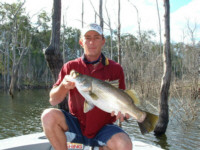 |
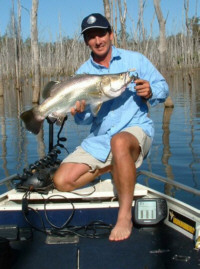 |
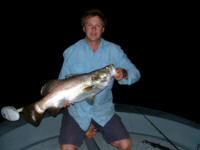 |
|
This
fish was taken during a morning session with the moon above.
|
A
moon below, warm water temperature during late afternoon saw
this Monduran Barra caught.
|
It
can pay off to stay on the water late if there is a moon peak
coming up.
|
Click
on images for larger version
Water
Temperature
The first is relative water temperature difference and what I mean
by this is a slight lift in water temp compared to the rest of the
dam.
One of the best afternoons I have had on Lake Monduran I experienced
in water temps of below 20 C, now some years ago the common belief
was barra would not bite at that water temperature.
This came about because the basin in Monduran was at a chilly 18
C on that August afternoon but I managed to find a bay that contained
water that, in the afternoon sun was at 19 C and that is where the
barra chewed that afternoon.
It is a relative difference you are looking for when chasing water
temperature around lakes and if you can find a jump of even 0.5
C or more that is a place well worth trying if some other factors
line up with that location.
Moon
Phase
The second thing I like to watch is the moon phaze and more to the
point when moon above and moon below occur on any given day.
The moon most definitely has an effect on impoundment barra, I don't
know why but I suspect that the fish can sense a "tide"
and although we cannot measure the effect of the moon on our impoundments
the fish certainly know.
The easiest way to get hold of this information is to get yourself
an Anglers Almanac, most tackle shops would stock them.
In my opinion the moon below is by far the more powerful bite time,
it is however generally a shorter bite period but it is usually
mayhem when the barra bite on the below moon.
So now if I manage to find relatively warm water and I am out there
for moon below or moon above that is 2 of the 3 factors I need,
now I am starting to get confident they will fire.
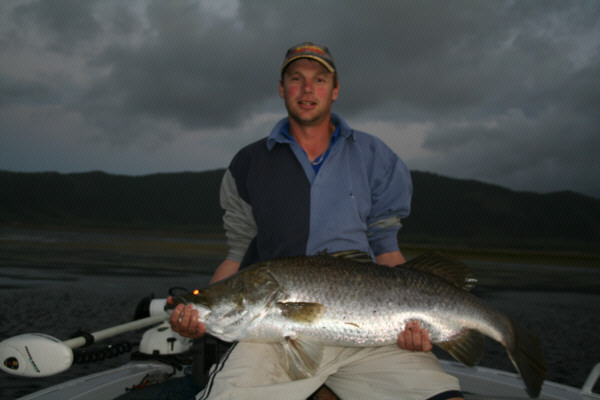 |
|
Two
out of three aint bad... Cold water temperature but with the
moon below on dusk the barra came on like a switch had been
flicked.
|
Light
Periods
The third factor is what most fish bite on and that is the low light
period at either end of the day, I do find the afternoon bite a
little more productive than the morning.
Now of course once it is dark we can still catch barra but the small
time window just as the light passes from dark to light is well
worth fishing regardless of any other factor.
There is other factors like barometric pressure and is the dam level
is rising or falling but I have found these factors to have little
or no effect on when and where barra bite in a dam.
Location with-in the dam is not to be disregarded of course, if
the water temp is right in an entire bay I will go strait to where
I think the fish will be first.
For instance, if I am at Monduran I'll head for 10 feet of water
and cast towards to bank targeting points and where weed beds jut
out to try and come across some active barra. This means I have
caught fish when most others have pulled off the dam because they
perceive the barra to be shut down for the day, remember they eat
everyday so at some point we are in with a chance.
Now I don't mean to suggest that we all should only fish for barra
in these zones when everything should come together, far from it
and the opposite is how I fish armed with this information. It allows
me to fish all day when conditions are right and if I know a major
bite time is coming up a few hours after dark I will stay out there
through the inactive period so I can fish right through the period
when they become active.
For instance, if I am fishing Lake Awoonga for an afternoon session
I'll head for where I know the water to be warmest and then fish
the low light period.
If I also have a moon above or below event before say mid night
on that night I'll stay out there and see what it produces.
If everything comes to together and I get warm water with moon below
late in the afternoon (these conditions have never failed me) I
will fish through until about 8 or 9 pm and then head home as the
next serious bite time will most probably be just on dawn the next
morning. Instead of staying out all night and being too tired to
take advantage of the morning bite I'll go in and get some rest
and be bck on the water fresh for the next peak period.
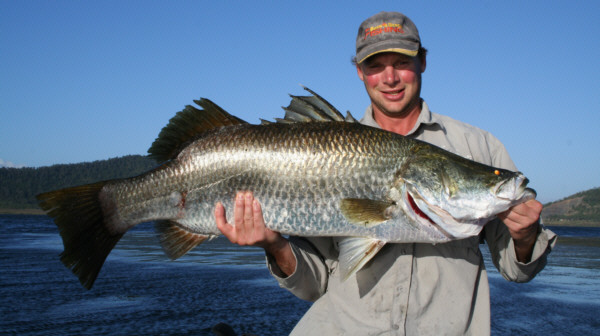 |
|
A
bad moon time for fish but with warm water in late afternoon,
it always pays to have a lure in the water.
|
There
are many other factors that help when chasing barra that needs some
consideration as well. Lures used, depth of water, structure and
food webs but in general the factors I have outlined put a bit of
the puzzle together for me when I'm out there chasing them.
I have found barra biting in cold water but when the moon below
event was in full swing and I have found them in warm water no-where
near a low light period or moon event.
Each of these factors will influence barra to a degree but when
we get two or more of them to line up at the same time I have found
this scenario to be the most successful.
It is not rocket surgery, it is just being aware of what is happening
and when on the dam you happen to be fishing on.
Any
Questions can be posted on the Sweetwater
Feedback Forum.
Birdy
Related
Topics:
Gearing
up for Big Lake Barra - Jason Bird
Lake
Awoonga - Information Page
Winter
Barra - Shallow or Deep - Garry Fitzgerald
Lake
Awoonga Hot Spots - Johhny Mitchell
|








